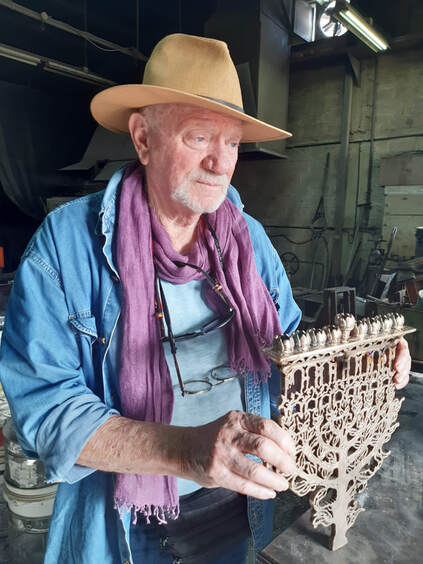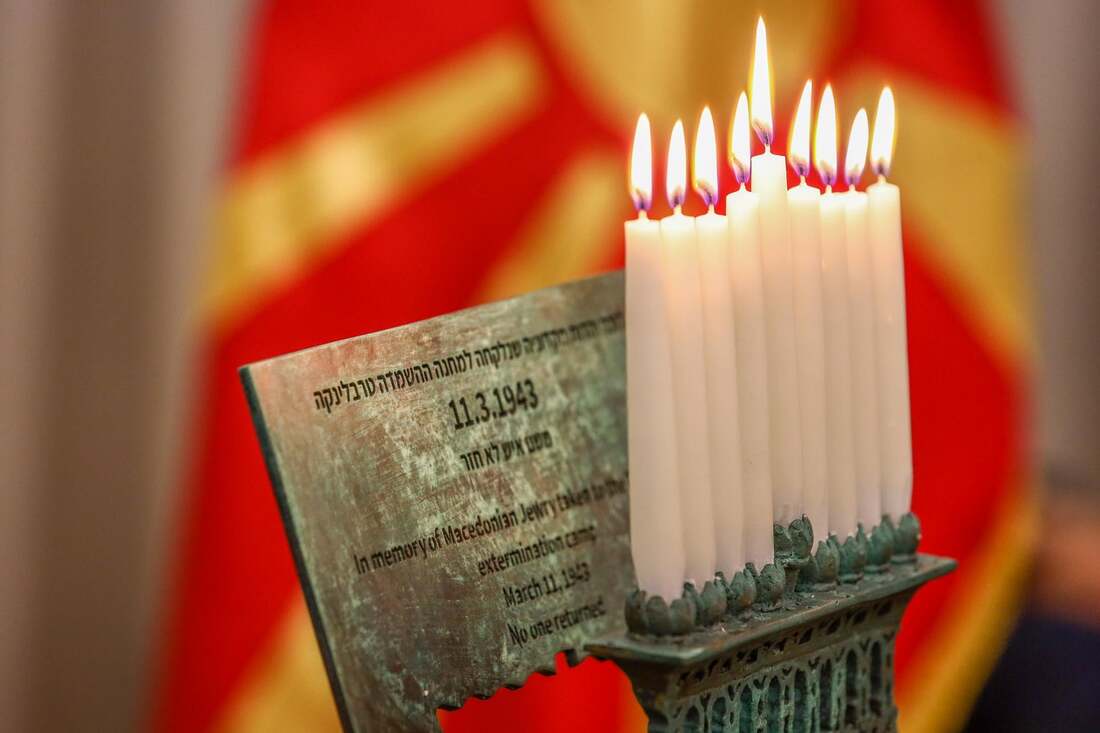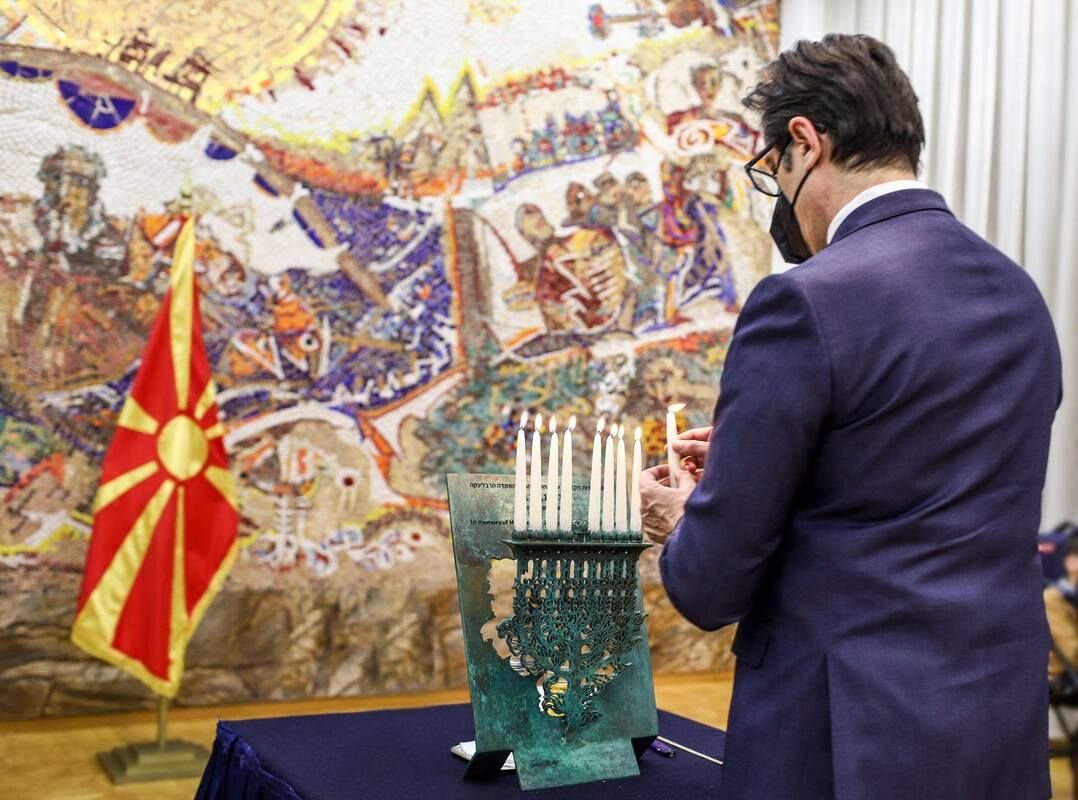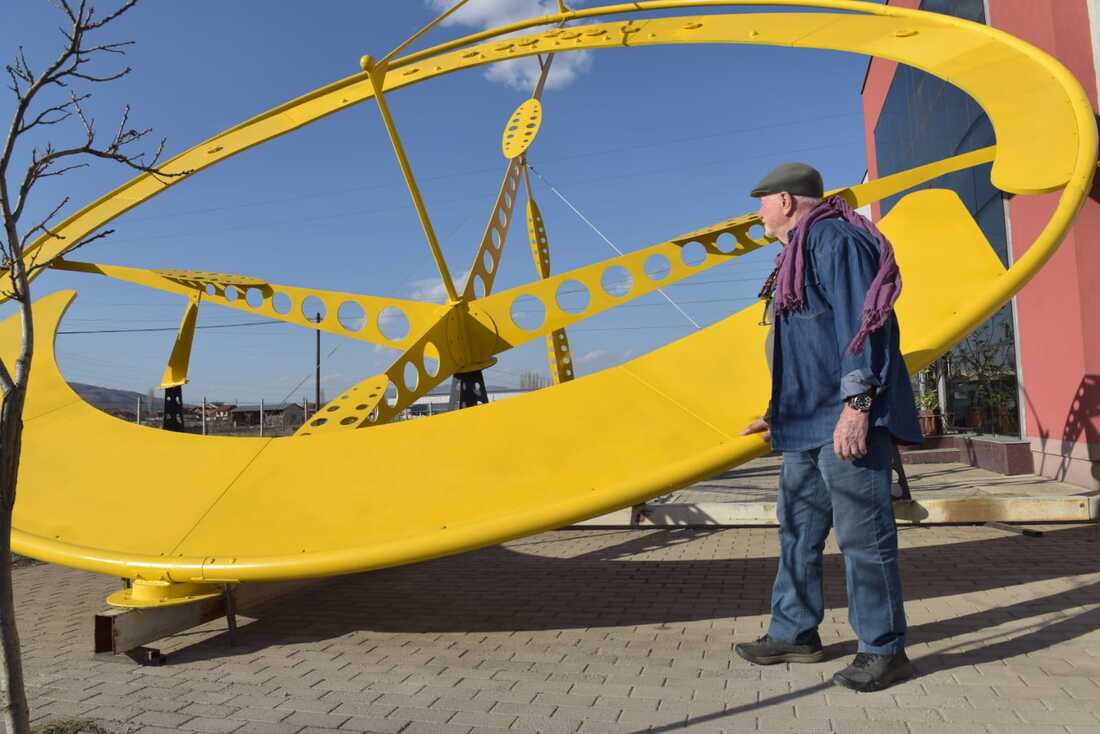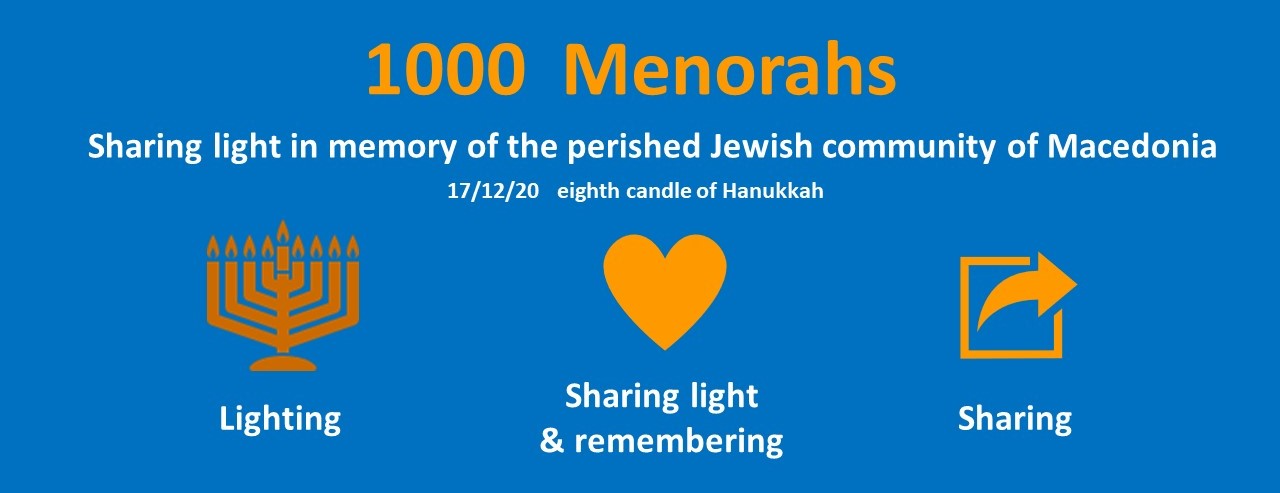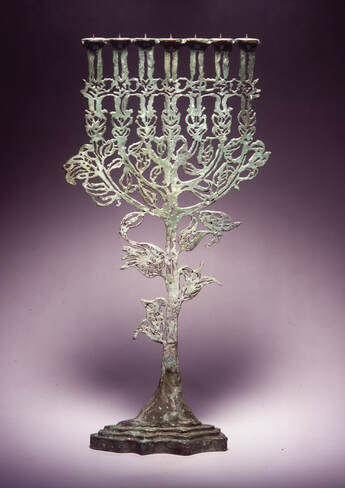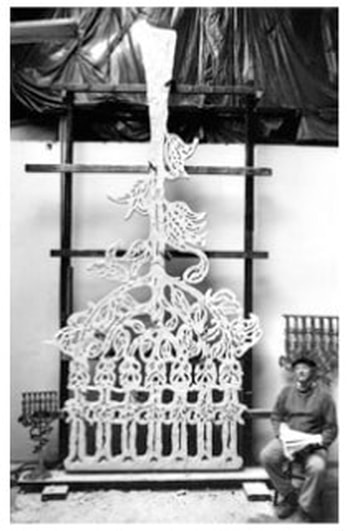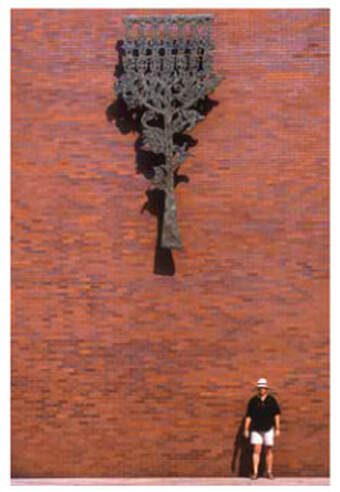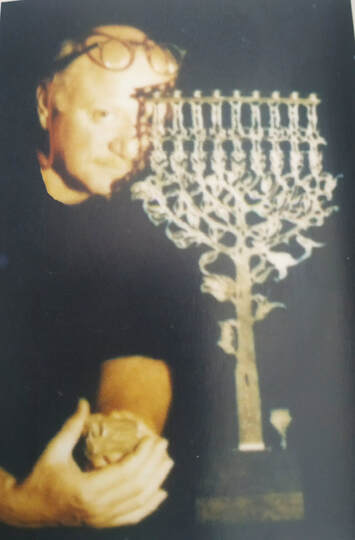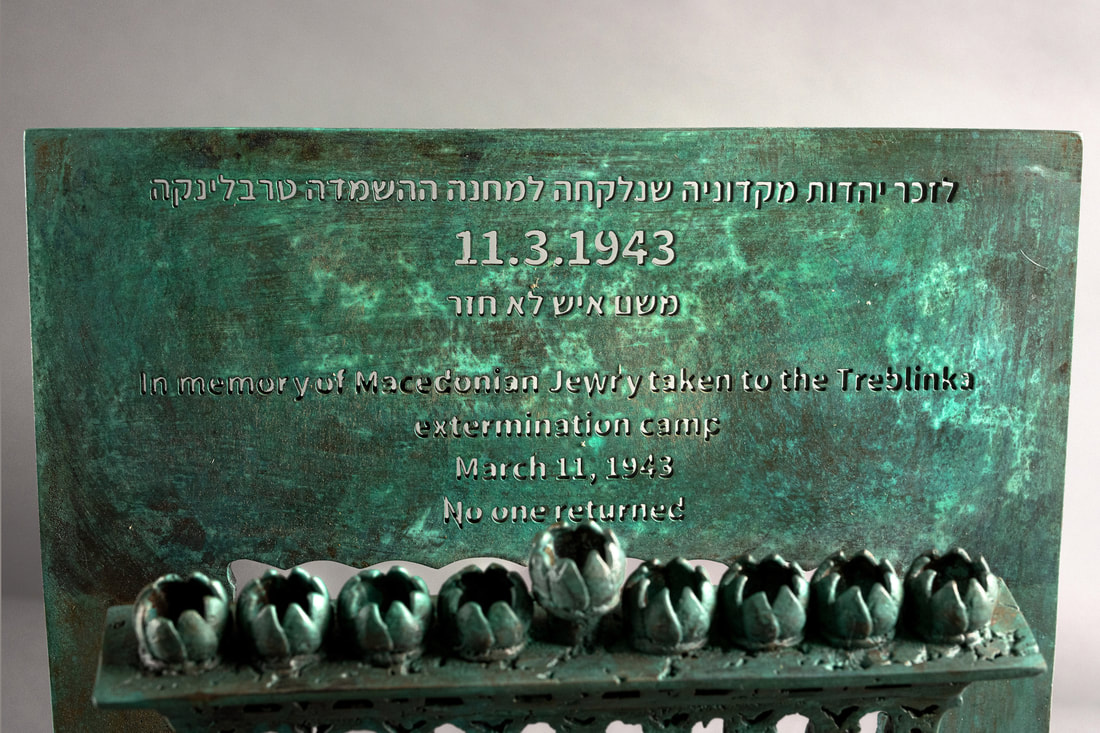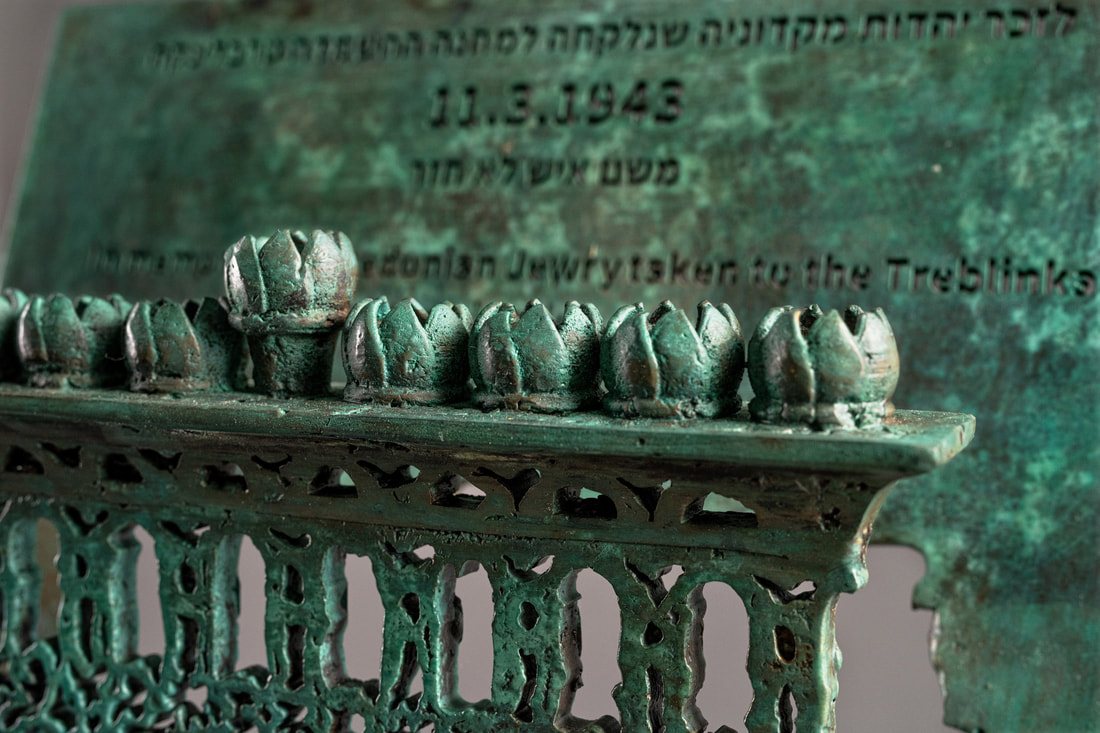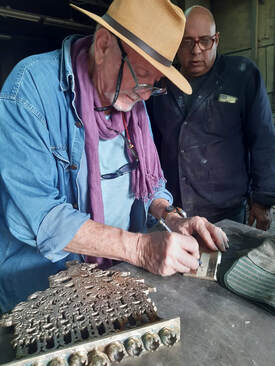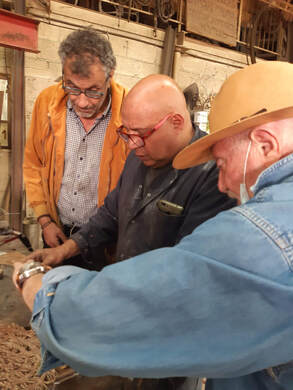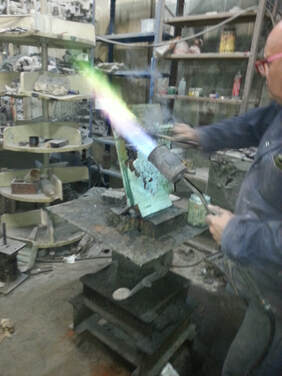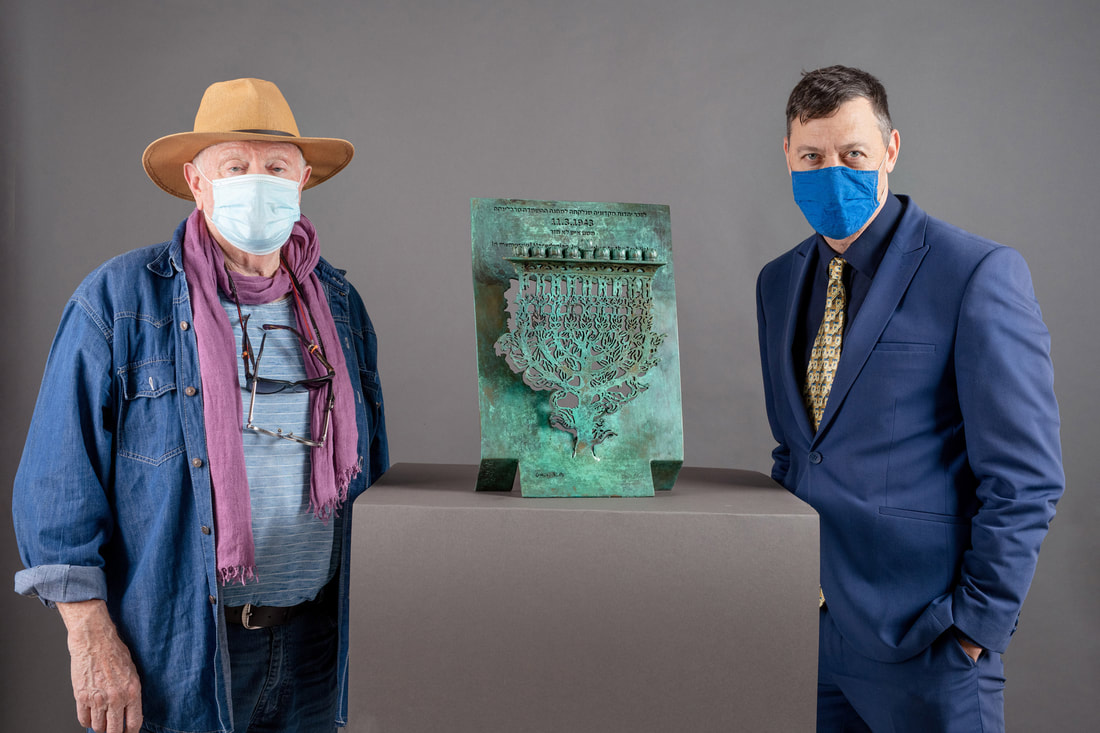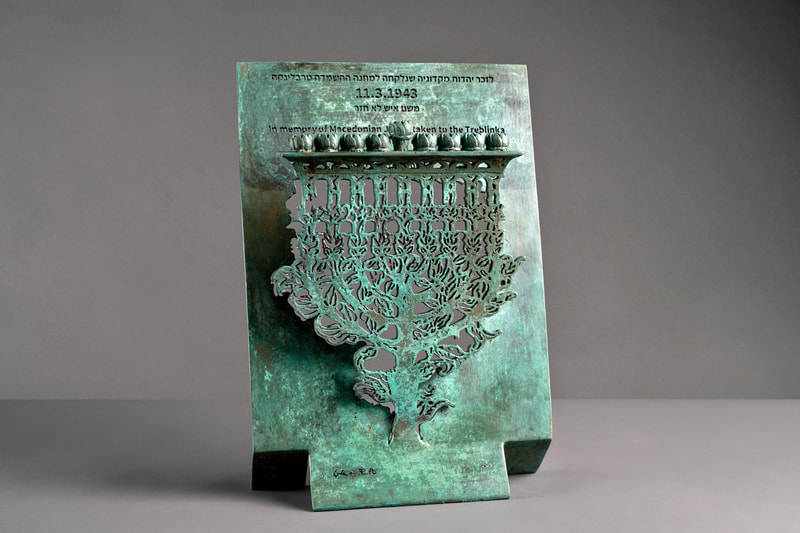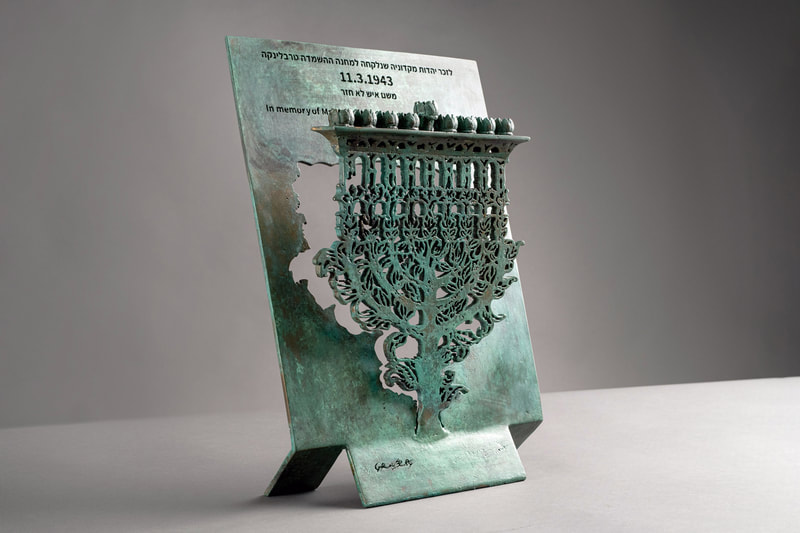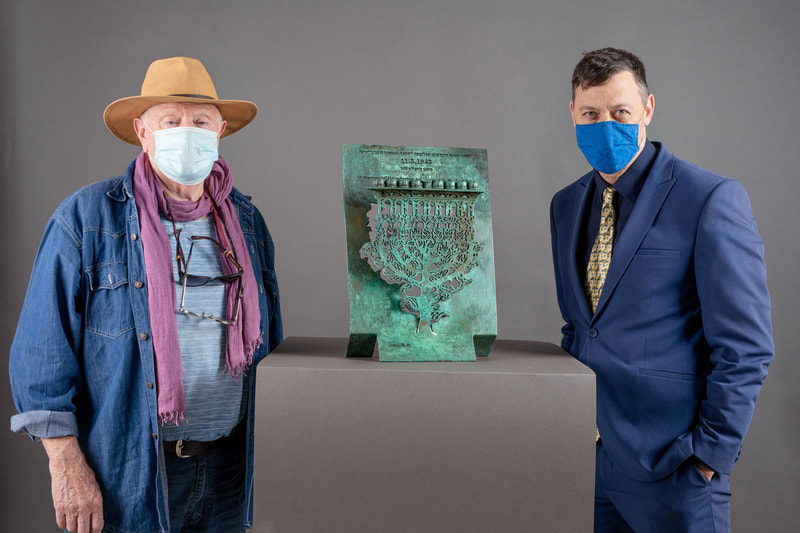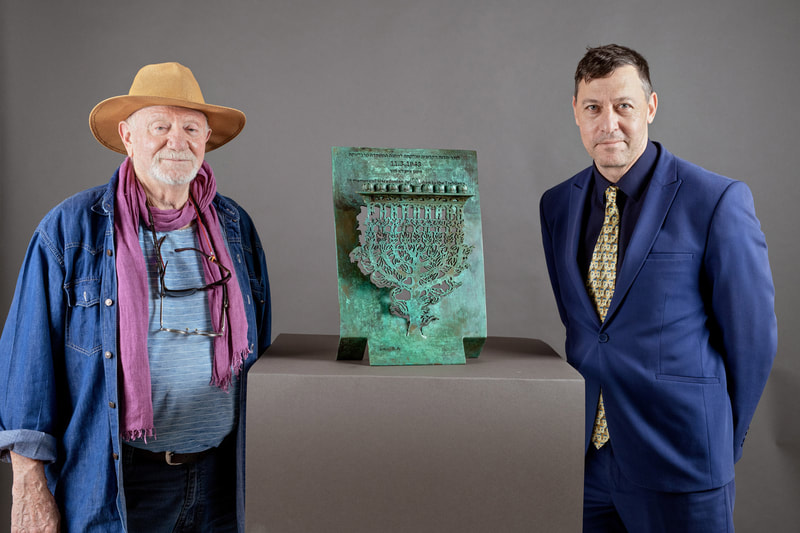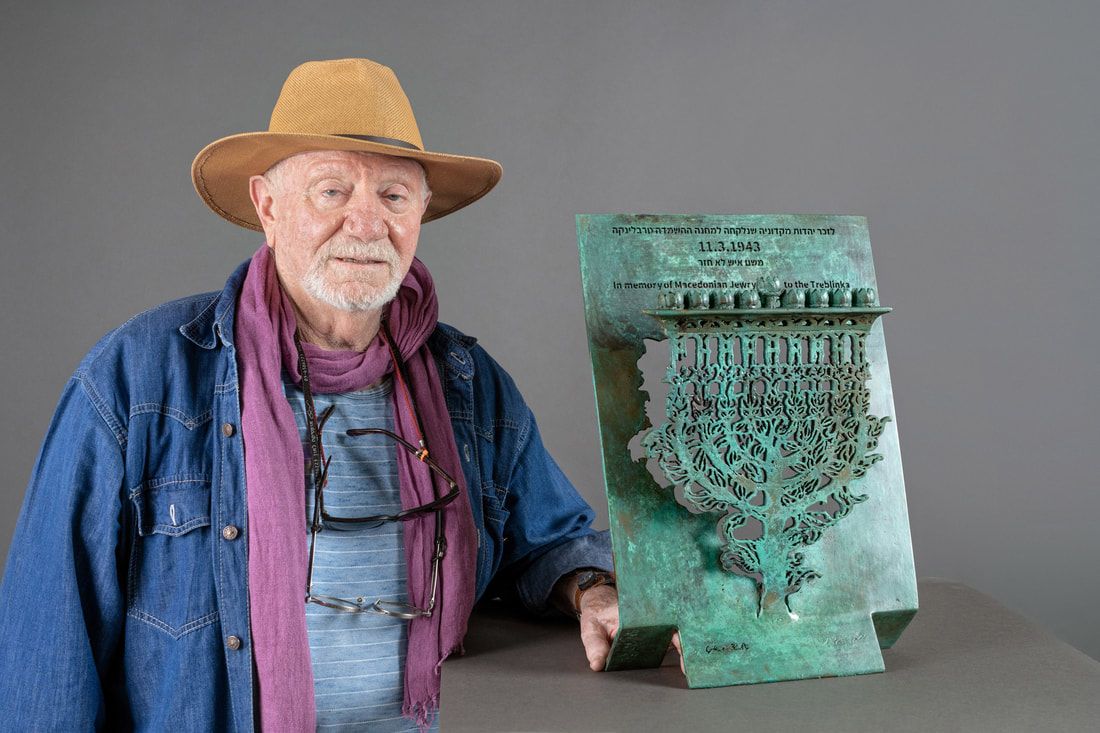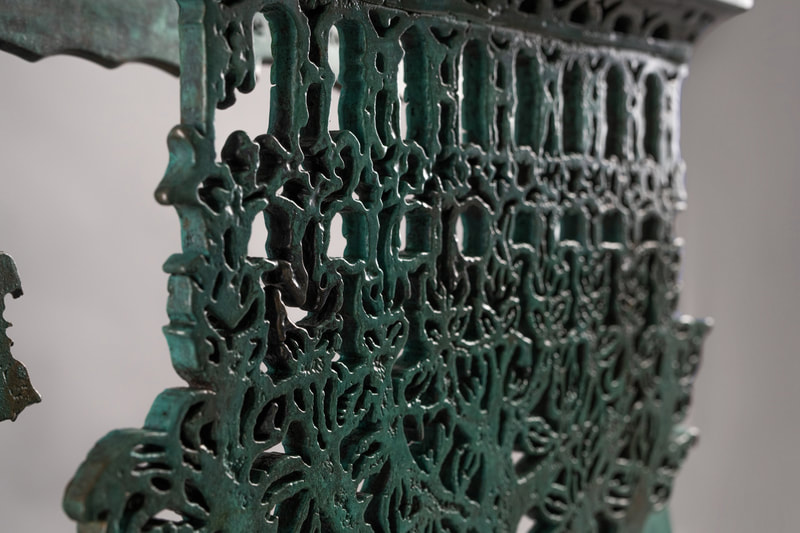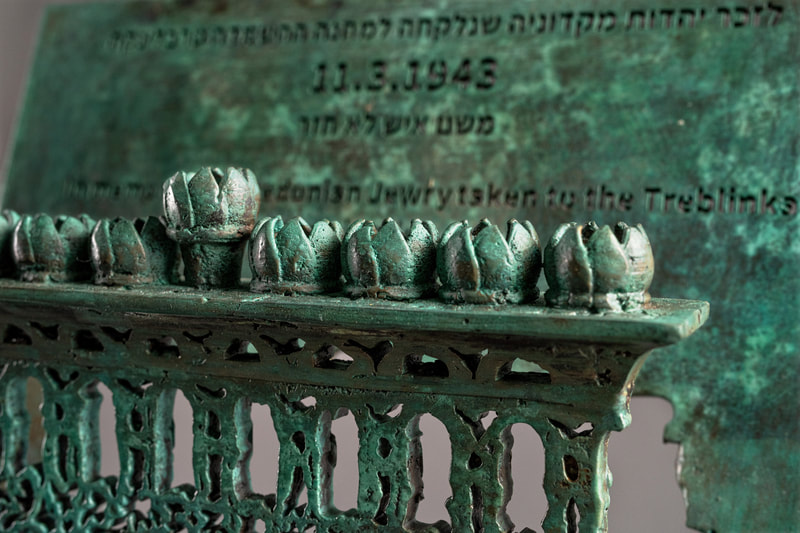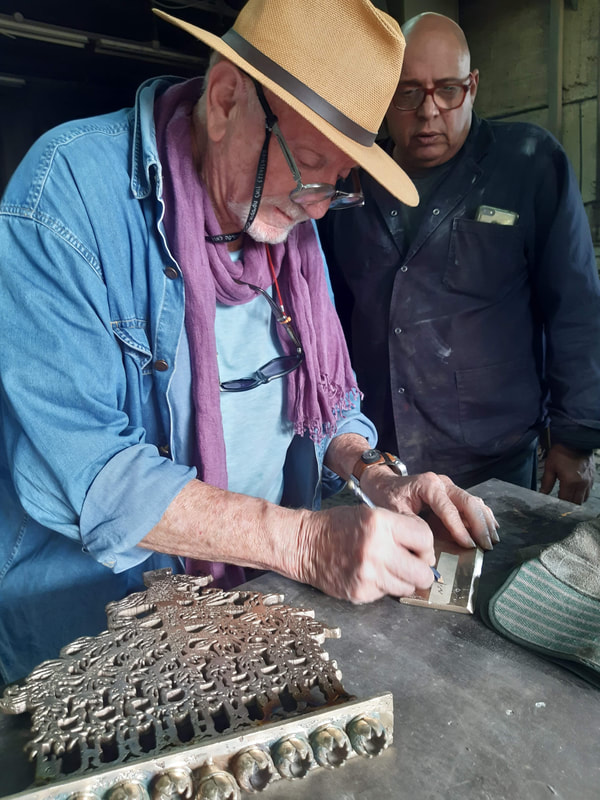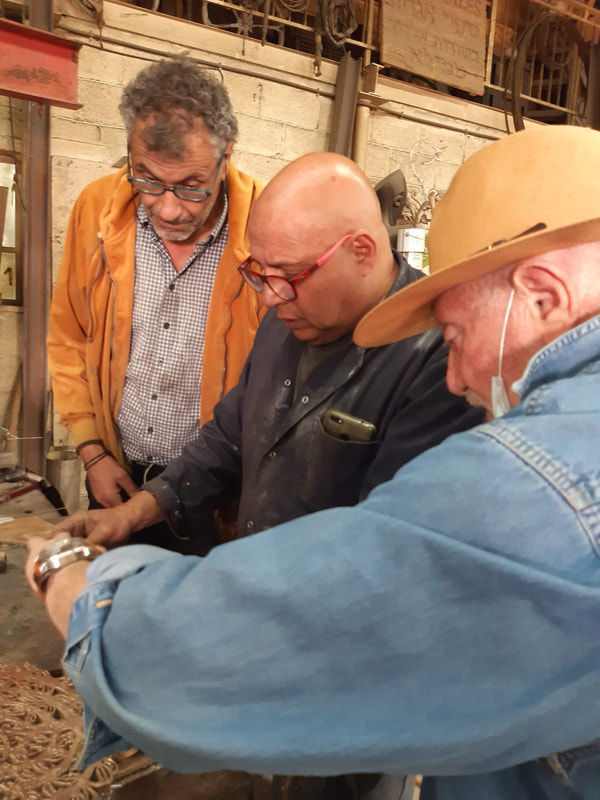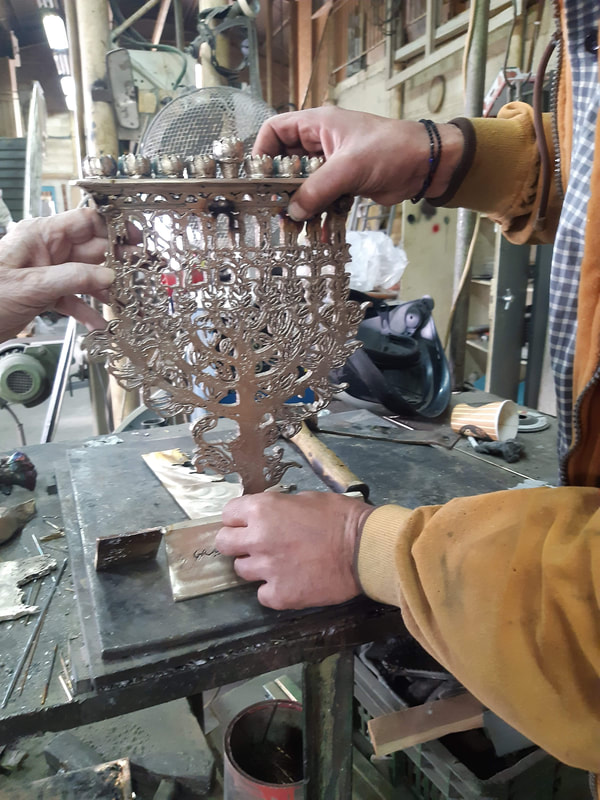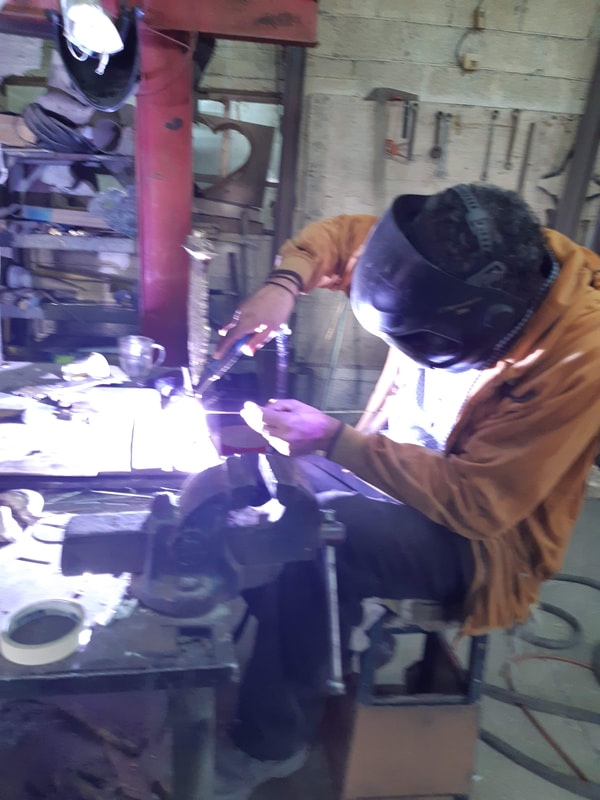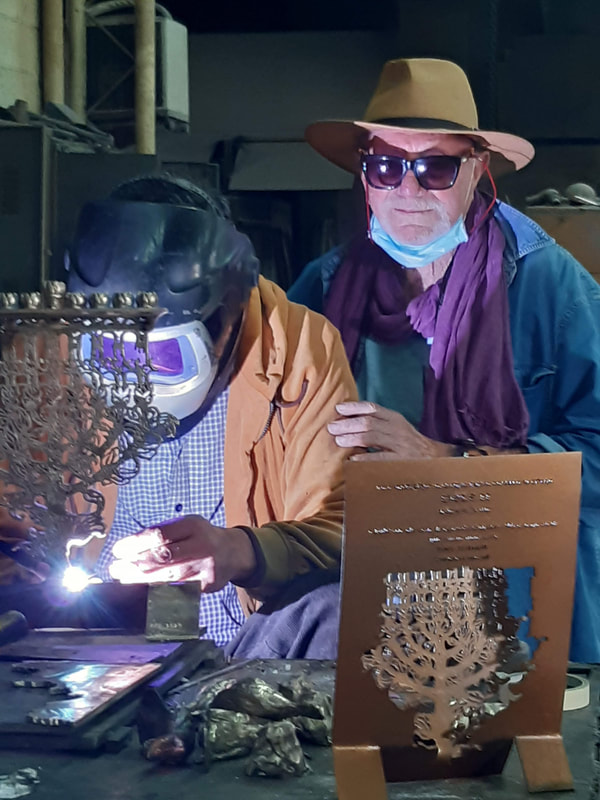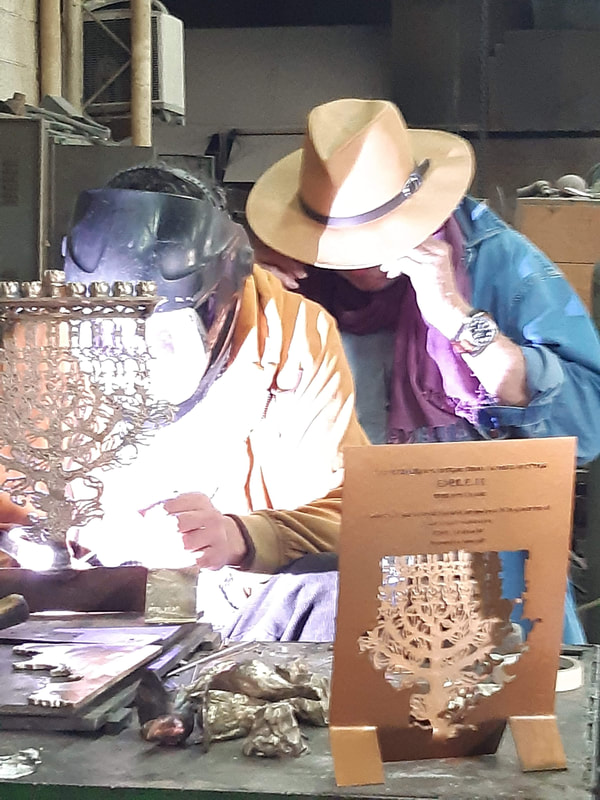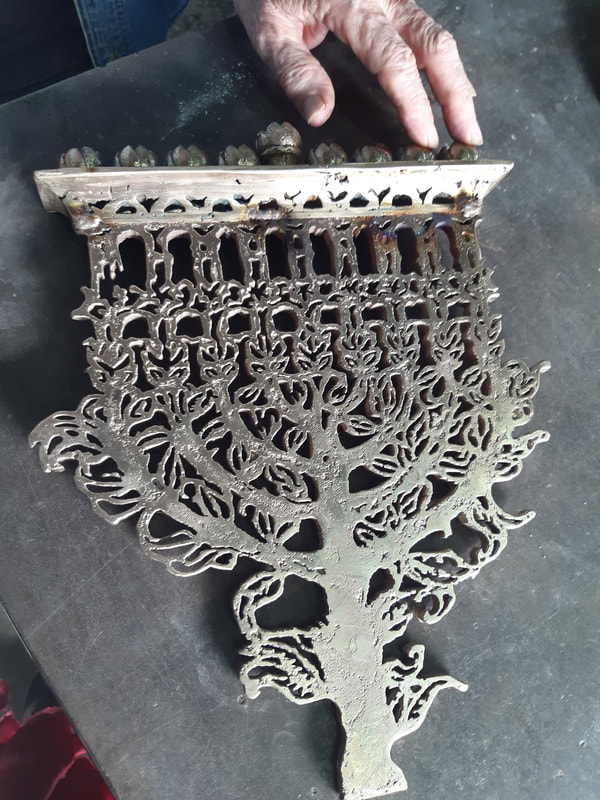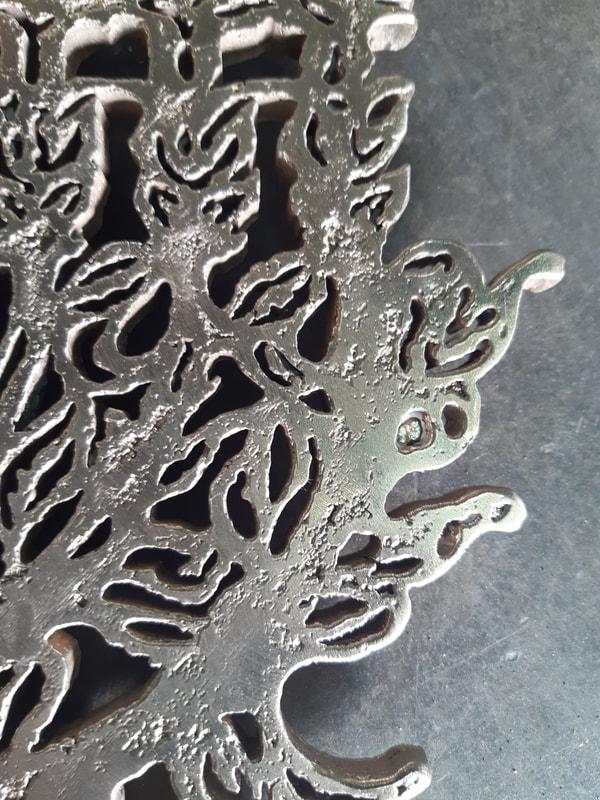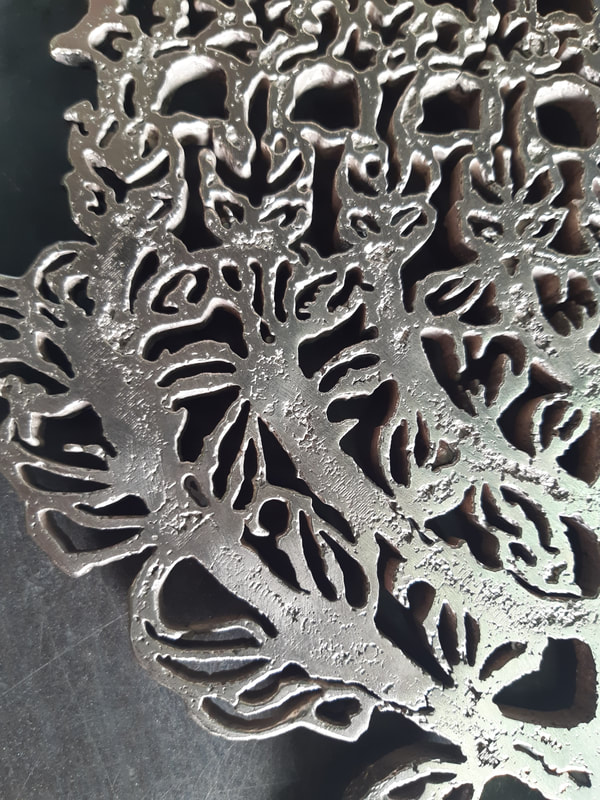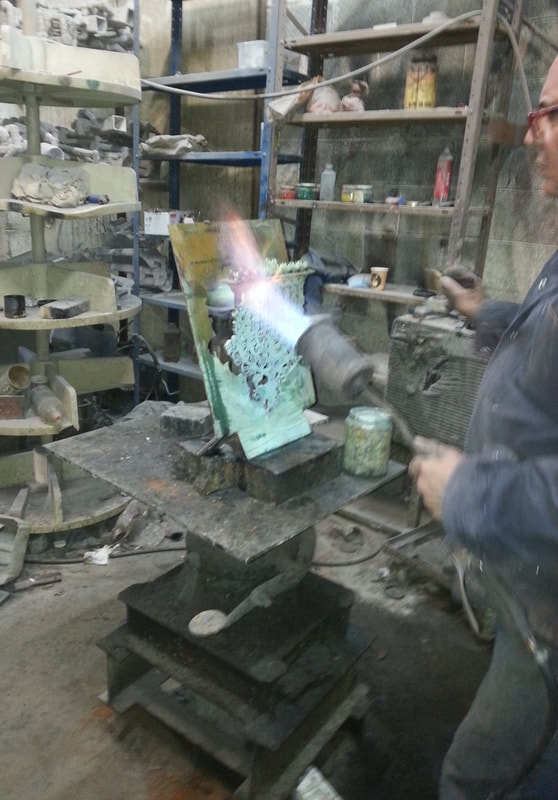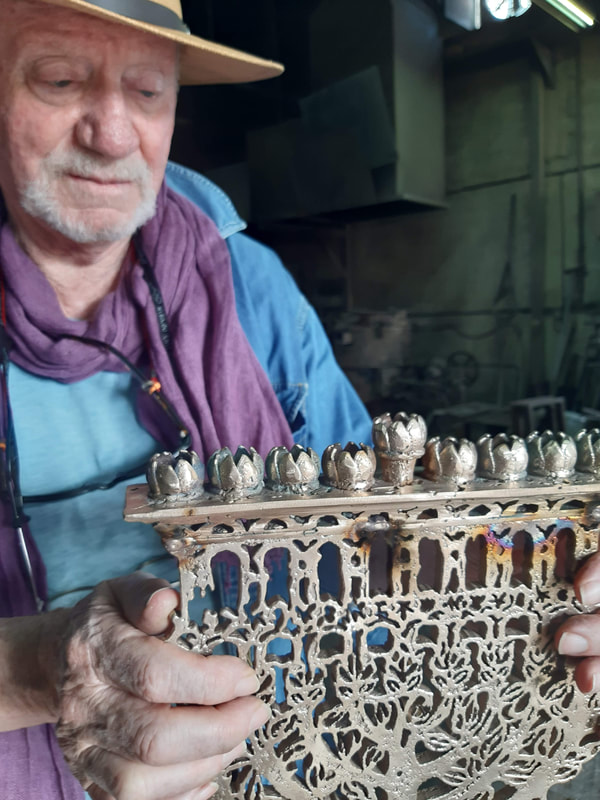Hanukkah 17/12/2020
Writing is remembering
By Hava Pinhas-Cohen, an Israeli poet, living in Jerusalem.
Tonight, the eighth candle of Hanukkah, December 2020, an ancient and also new work of art will stand on the table of the President of Northern Macedonia Mr. Stavo Pendrovsky. This will be the hanukkiah, Hanukkah Menorah, nine branches, four on each side and one (shamash) in the center. It is one of the oldest and most recognizable symbols of the Jewish world. The Menorah that will reach the President's office is a work of Maty Grunberg. Maty is an artist, he was born in a hide in Skopje, capital of N. Macedonia (then Yugoslavia) in March 1943. On the week of Maty's birth the Bulgarian police (who occupied Macedonia with the Nazis) gathered and concentrated the entire Jewish community of Macedonia, from Skopje, from Bitola /Monastir, and other cities. Men, women and babies were gathered and sent to "Monopole" tobacco factory, in the center of Skopje, and from there deported by train to Treblinka extermination camp. Maty's life and the lives of his parents were saved. In 1948 they arrived in Eretz Israel and settled in the city of Bat-Yam.
Tonight, I will stand with Ambassador Dan Oryan and Dr. Rachel Drummer Levy, and many others, at the Ministry of Foreign Affairs in Jerusalem, and shine a light on all worlds. In recent years, every year in March, an organizing operation has begun under the leadership of Dan Oryan, Israel's Ambassador to N. Macedonia and the Balkans, and Dr. Rachel Shelly Drummer Levy, who heads the Monastir-Bitola Community Heritage Association, she is also Bar-Ilan University's Academic Secretary. Thanks to the initiative of Dan Oryan and Shelly Levy Drummer I traveled three times to participate in the March of Living between March 8 and 11. I saw Maty Grunberg sculpt and erect the large sundial sculpture that will be placed in the heart of the oldest Jewish cemetery in the Balkans, in Bitola/Monastir, in memory of Macedonian Jewry. The sundial sculpture is ready and was supposed to be placed last March, but it is waiting in a workshop next to the cemetery until it will be placed in the cemetery. The sundial will create the narrative connection between the life of Maty Grunberg and his family and the community that ascended to heaven without a grave and tombstone. Absence and presence will have a dialogue through the dial and the sun. The light and time were born together on the same day God said: "Let there be light." Darkness and chaos are self-evident, they are pre-creation, light and time are the first creations of God when he came to create the world, without them a world would not exist and without them human culture could not exist. The sundial that connects the cosmic light with the human order, will bring back to consciousness the memory of the community that perished and disappeared.
This year, the year of the corona, in March 2020 the March of Living did not set off. With special creativity another way was found to mark the event and tie the events to the light, to illuminate and light a thousand hanukkiahs in N. Macedonia, Israel and around the world in memory of the community that perished.
Maty Grunberg told me about the hanukkiah he is preparing for this special occasion, in which the President of N. Macedonia will light the eighth candle. He added that it is will be casted in bronze in the foundry in Beit-Nekofa. On the day of the casting I joined the workshop to see how the menorah comes out of the material into the light. The roots of the menorah that went to Macedonia are in the Book of Exodus chapter 25 in the instructions received by Bezalel Ben Uri, the first Hebrew artist. He received precise verbal instructions and had to interpret the instructions and implement the work in practice. Bezalel Ben Uri built the menorah that was placed in the Tabernacle and later in the Temple. For generations, commentators on the verbal instructions for building the menorah, which was originally pure gold, have emerged. After the destruction of the Temple we find copies and interpretations of various artists in materials like mosaic, relief and iron. The menorah became a symbol that the Jewish people carried everywhere they went. As one can see in the menorah that was engraved in the famous relief of the Titus Gate in Rome, the gate that heralded the victory of the great kingdom of Rome over the small and rebellious kingdom of Judah, located at the distant border of the empire. Maty Grunberg, joined the line of Jewish artists who continue to read the instructions in the Book of Exodus and transfer the words to the three-dimensional interpretation.
31 “Make a lampstand of pure gold. Hammer out its base and shaft, and make its flowerlike cups, buds and blossoms of one piece with them. 32 Six branches are to extend from the sides of the lampstand—three on one side and three on the other. 33 Three cups shaped like almond flowers with buds and blossoms are to be on one branch, three on the next branch, and the same for all six branches extending from the lampstand. 34 And on the lampstand there are to be four cups shaped like almond flowers with buds and blossoms. 35 One bud shall be under the first pair of branches extending from the lampstand, a second bud under the second pair, and a third bud under the third pair—six branches in all. 36 The buds and branches shall all be of one piece with the lampstand, hammered out of pure gold. 37 “Then make its seven lamps and set them up on it so that they light the space in front of it. 38 Its wick trimmers and trays are to be of pure gold. 39 A talent[f] of pure gold is to be used for the lampstand and all these accessories. 40 See that you make them according to the pattern shown you on the mountain.
Exodus 25 is the source for the construction of the temple lamp / menorah. Clear instructions on how to build and from what materials the lamp should be built. In two places the instruction is repeated: "of one piece with the lampstand", meaning – in one cast. The description of the lamp is very detailed, one can almost visualize the menorah in his eyes. The construction is clear: six branches are arranged symmetrically, and the decoration is a button and a flower. The whole decoration is from the plant world. And from the description it is clear that as soon as a light is lit in it, there is a reflection of the light in the texture material of the lamp. Perhaps the detailed instructions on the material from which the lamp will be made, its structure and its ornaments, are a way of saying that spirituality and sublimity can be expressed even from the material.
As soon as the 1000 Menorahs / Hanukkiah Lighting Project in Memory of The Macedonian Jewish Community was launched, it was clear that one of the menorahs would be by Maty Grunberg. And indeed, when Ambassador Dan Oryan came to Maty Grunberg's studio and saw the model he decided that this was the menorah to be lit in N. Macedonia on the President's table. The menorah Maty Grunberg created is the 1001st menorah. It's prototype is in New York at the Hebrew Union College; it is a meter-high menorah that was built for the synagogue of the Hebrew Union College. It was commissioned by a couple of Jewish donors - Richard and Joan Scheuer. That menorah was designed according to the lamp model of Bezalel Ben Uri, according to the instructions given in the Book of Exodus chapter 25. The instructions say that it is to be built as one piece, and the branches have to be done in the ornamentation of vegetation.
A short remark: The Menorah has 7 canes, 3 on each side and one in the center. Menorah is a symbol of the state of Israel. Hanukkiah has nine branches and is used only on Hanukkah festivity.
At the day of the casting I met Maty in Beit-Nekofa, at the foundry - the place where all the great works begin - the transition of the primordial raw material into a creation. It was a bright, wintery day outside in the Jerusalem mountains. Organs molds of sculptures that have already been born were lying around the foundry. Maty then told me the story of the birth of his hanukkiah many years ago in New York, quoting the instructions from the Book of Exodus and emphasizing the concept of "one-piece" which is repeated twice. In 1988 he was commissioned to create a hanukkiah made of pure sterling silver, for Gale & Steven Spira, a couple of private collectors in New-York. The hanukkiah was to be casted of four kilograms of sterling silver. This presented a huge challenge for the silversmith in London. When Maty brought the project to the silversmith craftsman he thought it was impossible to cast in one piece. He advised Maty to cast separately different parts of the hanukkiah, then solder them to each other. Maty insisted: "but they did it that way thousands of years ago, it is written in the Bible".
Maty then approached his old bronze foundry, Meridian, and consulted Len, an old Irish man, the most experienced craftsman. Len also thought it was impossible to cast the whole hanukkiah in one piece, because the liquid silver will harden too fast. But, as Maty encouraged him with two bottles of fine Irish whisky he committed himself to the project. Maty describes the casting process :"we held the hollow ceramic mold upside down, and poured the liquid silver top down, from the lampstand to the branches. We constantly warmed it with a flame thrower, and we turned on a vacuum machine that sucked the silver down. Late on, when we broke the ceramic mold, we saw that the silver spread well to all the branches. Len, the old Irish man said: "it was the most complicated casting I made in my life". Maty adds: "If Bezalel Ben-Uri did this thousands of years ago, it was a great challenge for me to find a technical solution to cast a one-piece hanukkiah now a days."
I learned this lesson from Maty at the entrance to the foundry in Beit-Nekofa.
Maty then approached his old bronze foundry, Meridian, and consulted Len, an old Irish man, the most experienced craftsman. Len also thought it was impossible to cast the whole hanukkiah in one piece, because the liquid silver will harden too fast. But, as Maty encouraged him with two bottles of fine Irish whisky he committed himself to the project. Maty describes the casting process :"we held the hollow ceramic mold upside down, and poured the liquid silver top down, from the lampstand to the branches. We constantly warmed it with a flame thrower, and we turned on a vacuum machine that sucked the silver down. Late on, when we broke the ceramic mold, we saw that the silver spread well to all the branches. Len, the old Irish man said: "it was the most complicated casting I made in my life". Maty adds: "If Bezalel Ben-Uri did this thousands of years ago, it was a great challenge for me to find a technical solution to cast a one-piece hanukkiah now a days."
I learned this lesson from Maty at the entrance to the foundry in Beit-Nekofa.
We entered the foundry, and amidst the chaos of metals and pieces of work, the model of the menorah stood on a working bench, still in the process of making. its back panel seemed to me like a tombstone. The following chilling sentence was engraved on it:
In memory of Macedonian Jewry taken to Treblinka extermination camp.
March 11. 1943.
No one returned.
March 11. 1943.
No one returned.
The hanukkiah was completed, but was not yet attached to its pedestal. It was all casted, adorned with spectacular plant decorations. At the end of the canes, at the end of the branches, Maty's interpretation of the almond goblets that form the cup for the Hanukkah candles, the source of light.
While I was watching, Ilan Shoshani, the owner of the workshop, and Ibrahim, one of the pourers, came to weld and connect the menorah to its pedestal. Maty Grunberg then signed his work and added an instruction: "the color of the patina should be light olive green". A controversy has arisen as to the nature of the color in the artist's imagination, whether to add white or black color to the green bronze patina. The next day I saw the photo of the menorah after it had dried, and I realized that Ibrahim well understood Maty's request.
Tonight is the eighth candle of Hanukkah. Mr. Stavo Pendrovsky, the president of N. Macedonia will light eight candles in the 1001st hanukkiah Maty Grunberg created in memory of his ancestors, the Jews of Macedonia. An entire Jewish community that was exterminated in March 1943, and there was no one to save them.
The light of the 1000 menorahs that will be lit tonight will illuminate the memory of this community.
AMEN.
The light of the 1000 menorahs that will be lit tonight will illuminate the memory of this community.
AMEN.
This article was written by poet Hava Pinhas-Cohen, http://havapinhascohen.co.il
Free translation by Naomi R. Azar
Free translation by Naomi R. Azar

